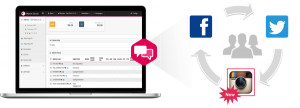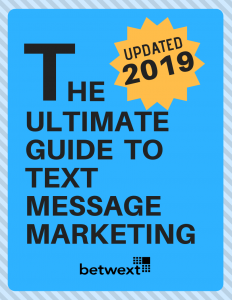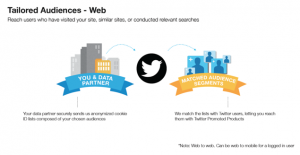
My beautiful mother, who is “technologically challenged,” told me about the Cole Haan boots she found online that followed her around the internet. “It was so weird. I saw them on Facebook three times in the last two weeks so I ordered them. I figured it must’ve been fate,” she said.
I didn’t have the heart to tell her that it was not fate, it was remarketing. We’ve all been victim to the power of remarketing. In fact, I’m often prey even though I’m fully aware what these sneaky advertisers are up to.
What Is Remarketing?
For those of you unfamiliar, remarketing works by following your leads around the web with related offers. When a user visits your website they are “cookied” or tagged. To remarket to these visitors, a code is placed on the page that the user visits, which then triggers your ads to follow that cookied user around the web, whether that be on a social media site or on various websites across the internet. So when you see ads on the sidebars or top banners of other sites of the new dining set you just browsed on Pottery Barn, this isn’t a coincidence or “fate,” it’s remarketing.

Remarketing comes in many shapes and sizes. For instance, Google AdWords allows advertisers to remarket through their platform by creating remarketing lists with a set of rules. You can targeted all website visitors or you can target visitors who came to a specific page on your website or completed a specific action. Then Google will trigger your ads to show to the same visitors on websites across the Google Display Network.
What Is Facebook Remarketing?
Facebook remarketing works similar to Google AdWords remarketing, but rather than showing your ads across websites within the Display Network, your ads are shown on Facebook. Facebook also more commonly refers to remarketing as “Custom Audiences.” The concept is the same: someone visits your site or interacts with your brand, they’re tagged with a code you implement to track them, and then while they’re scrolling through their Facebook feed your ad pops up to remind them what they’re missing.

Website Traffic
This is the flavor of remarketing that you’re likely most familiar with, which will serve ads to people who have visited your site within a set time frame. Once you’ve placed a Facebook pixel on all pages of your site, you can set up specific audiences with filters based on pages they’ve visited. For instance, if you sell running gear, but you want your Facebook ads to target people searching for sneakers, then you can set up an audience that shows ads to just people who have visited pages with the keyword “sneakers” in the URL.
App Activity
Finally, you can target based on app activity. If you have an established app this is typically a good option, and there are multiple ways to show relevant ads to the right people based on user behavior. For instance when someone abandons a shopping cart within your app you could target them with the same product and special discount code. You can reach people who have recently opened your app, recently completed a purchase (to upsell), or achieved a certain level in a game.
Why Should I Remarket On Facebook?
Why wouldn’t you?
“Remarketing is life,” said WordStream founder Larry Kim when I asked him his thoughts on it. “Your lowest hanging fruit can be converted by using Facebook’s custom audiences and site visitor remarketing tactics. It’s ridiculously awesome and you’d be stupid to ignore it.”
Still not convinced? With Facebook’s active monthly user base larger than China’s population, and 22 billion ad clicks per year, the opportunities to gain more business through Facebook ads are endless, and what better way to start than with familiar faces?
Just think about it like the dating pool. You’d be more comfortable going on a second date with someone you’ve already had a pleasant evening with, rather than a blind date which is much more intimidating and the chances of flaking are higher. The same goes for advertising. If someone has already visited your site, downloaded your e-book, or engaged with your app, the chances of them interacting with your ad and purchasing from your brand are much higher than if they saw your brand for the first time on Facebook. In fact, Facebook remarketing ads get 3X the engagement then regular Facebook ads!

Regardless, you should be advertising on Facebook, which makes remarketing on Facebook a no-brainer.
How Do I Get Started With Facebook Remarketing?
To get started with remarketing log into your Facebook Ads Manager account, select the “Tools” dropdown and select “Audiences.”

Then select “Create Audience” and “Custom Audience.”

On the next screen you can chose which type of remarketing list you want to create from the three I explained above: Customer List, Website Traffic, or App Activity.

Customer List
To import a customer list you can do so by either copying and pasting your customer list or uploading a file that contains emails, phone numbers, and/or Facebook user IDs (or mobile advertiser IDs). Facebook also has an integration with MailChimp if you chose to upload your list through the email server.

Website Traffic
Before targeting website traffic you need to create and install your Facebook pixel on all pages on your website (NOTE: if you installed a custom audience pixel in the past you can bypass this step). This is a one-time step since each ad account is only allowed (and only needs) one pixel to remarket to visitors. To do so…
- Go back to the “Tools” dropdown at the top of the page
- Select “Pixels”
- Select “Create a Pixel”
- Name and create your pixel
If you’re not in charge of placing code on your site reach out to your webmaster or developer and have them place the pixel between the tags on every page of your website. The pixel won’t start remarketing until you’ve create an audience tied to an ad campaign.
![]()
Now return to the “Create a Custom Audience” screen and select “Website Traffic.” On this page you can decide the parameters the site visitor must meet in order to get remarketed to. For instance, anyone who visited your site or just people who visited pages that contain the word “shoes” in the URL. Name your audience (for instance: “Shoe Shoppers,” “All Visitors,” “Visited Lead Gen Pages”), and create it!
Once you have your custom audiences set up you’ll need to either apply them to ad sets you’ve already created or create new ad sets that you tie to your customer audience(s). If you’re unfamiliar with the campaign, ad set, and ad creation process, refer to this guide.

5 Facebook Remarketing Best Practices
Now that you understand the value of Facebook remarketing and how to set it up, it’s important to ensure you’re doing it better than your competition. Follow these five best practices to run conversion-worthy Facebook remarketing campaigns.
#1: Buy Followers With Remarketing Lists
Are you looking to grow your page likes? Whether it be metrics you’re trying to hit to please your boss or providing legitimacy behind your brand on social, it’s always great to have high follower numbers, but growing these organically can be challenging. Luckily, Facebook allows you to run paid campaigns with the main goal of getting page promoters (see image below).
However, Larry advises that you should never buy followers unless it’s through remarketing! Why? Because you want to reach your “super-fans” to get the highest engagement rates possible, which will lead to higher relevance scores, cheaper clicks, and more organic visibility.

If you are an AdWords advertiser then you’re likely aware of how Quality Score affects your ad rank and the price you pay per click. Facebook has a similar metric called relevance score, which dictates how much you pay and how often your ads are shown to your target audience. The main influencer of relevance score is engagement rates, which are likely to be much higher if you’re showing your ads to Facebook brand loyalists.

You wouldn’t want a bunch of grumpy people who hate turkey to attend your Thanksgiving feast, right? The same goes for Facebook page likes. You want your Facebook fans to be brand ambassadors who are likely to engage with your content so that every post has a high relevance score, leading to cheaper clicks and more visibility. The best way to do this is to promote your page to people who are already familiar with your brand via remarketing!
Then there’s the added bonus of organic visibility. If one of your Facebook fans also “likes” your page posts, then that post is likely to show up to the users Facebook network of friends, leading to the potential to gain free likes and followers from this organic visibility.
#2: Remarket To People Who Have Already Liked Your Page
Now that you have the followers, you need to ensure they see and interact with your posts. Take tip #1 a step further by remarketing your boosted posts to your Facebook followers. This is a full-proof method because these people have not only already interacted with your brand, but they’ve interacted with your brand on the same platform you’re remarketing with, Facebook. If a user has taken the action of liking your page, then it’s clear they’ve embraced some level of brand loyalty, and the chances of them engaging with your posts are much higher. This again leads to higher relevance scores and organic reach.
#3: Layer Your Custom Audiences With Facebook’s Targeting Options
The level of granularity you can achieve with Facebook targeting options is absolutely mind-blowing. From targeting different variations of mom personas to the Prime Minister of Spain, if you know your audience well, you’ll have no trouble finding them. While it’s important to not get too granular and limit your reach, it’s even more important to not stretch your budget across an oversized arena of Facebookers since this will actually limit your visibility and lead to lower relevance scores (and less profitability).

Let’s say your remarketing audience is bordering on the larger side. Perhaps you’ve uploaded a list of 1,000+ contacts, but you only have $ 150 to spend. Rather than sprinkling a dollar here and there, you’ll be more effective if you combine this list with demographic targeting to hone in on the most in-market, ready-to-buy audience.
It’s all about finding the right balance between budget and audience size, but experimenting with layering targeting options on top of your custom audiences will likely increase your relevancy and allocate your budget to an audience that is more likely to convert.
#4: Think Strategically About Your Goal When Setting Time Frames & Creating Ad Schedules
Advertisers need to be cautious about fatiguing their remarketing audiences, but at the same time if buying cycles are longer or special offers are limited they need to be more aggressive. The life of a Facebook ad is typically short-lived, but rather then running your ad continuously until the budget runs out think about the goal of your ad. Are you running a Black Friday, limited-time discount on dining room sets? Then run the ad aggressively for the time of the sale, without frequency caps, to a remarketing list that looked at the one of your dining set landing pages, but didn’t convert. If you’re trying to simply promote your page to site visitors, this might be an on-going ad set, where you change the copy and imagery from time to time to keep your ads fresh.

Similar to AdWords you can also set up ad schedules to run your ads on specific days of the week and hours of the day rather then 24/7 all week long. If you’re a SaaS company and notice higher traffic and conversion volume Monday through Friday from 9 to 5, then create an ad schedule accordingly.

Moral of the story, when setting up your ad sets be strategic when it comes to timing and scheduling to get the best results possible.
#5: Find New Customers By Layering Lookalike Audiences Onto Custom Audiences
Lookalike audiences allow you to clone a relevant audience to expand your reach to an entirely new set of leads. This is an incredibly powerful way to expand your reach and find an untapped audience. What better way to do this then by cloning your remarketing list? These people have already converted by downloading an e-book or subscribing to your blog. You know this list is “in-market,” and perhaps you’ve already converted them and need to find new opportunities. By layering lookalike audiences on top of your custom audience Facebook will find leads that are similar in makeup and likely to be interested in your products or offerings.

(113)









